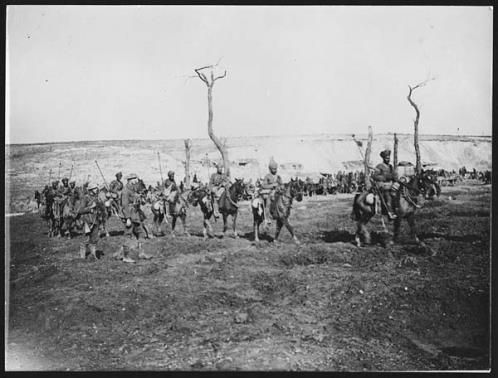
Indian Cavalry on the Western Front, Library of Congress, Prints and Photographs Division, Washington, D.C. 20540 USA, hdl.loc.gov/loc.pnp/pp.print, date unknown.
The Indian Army Corps in France from 1914 to 1915 were among the first non-European combatants to fight on the fields of France. However in this war no one country or creed worked alone on the allied front.Indians fought alongside the Scottish, Irish, and English battalions which formed part of each Brigade. And importantly from an Australian perspective fought with Australian soldiers in the Territorial units at Gallipoli, and in the Middle East campaign.
Before the first Australian troop ship landed in Egypt, and many months before the landing at Gallipoli, Indian troops were already fighting on the Western Front in France. On 5 September 1914 General Willcocks took command of the first divisions of Indian Army troops, on 26 September, just seven weeks after the declaration of war, two brigades of the Lahore division landed at Marseilles, France. This was notwithstanding the delays caused by the activities of the German raiders Emden and Konigsburg and the slow transport ships. The Sihind brigade had been dropped off in Egypt to reinforce the garrison there and did not make it to the front until November 1914.
The Army of India was little understood by the general public and many thought that Indian brigades and divisions were composed of Sikhs and Gurkhas alone, without including the many other races of India. Nor were they aware that in each brigade was a British battalion. A paper writing of the arrival of the Corps at Marseilles, solemnly announced that … this Corps has been raised and equipped entirely at the expense of three great Indian Princes,who are now occupying the finest hotels in Marseilles. Their names are Prince Sikya (evidently a corruption of Sikh); Prince Gorok (Gurkhas);and Prince Balukin (meant for Baluchis).
The Army of India in 1914 was trained for frontier war or minor overseas expeditions, and for these purposes was to a certain extent sufficiently well armed and equipped, but it was by no means fully so. The two divisions which sailed from Karachi and Bombay had to have their equipment completed at Marseilles, at Orleans, and on the battle front itself. The artillery was only made up by denuding the guns of other divisions and the rifles could not fire the latest class of ammunition with which the British Army was supplied. As a result both rifles and ammunition had to be handed into store at Marseilles and fresh arms issued making things difficult for the troops as most soldiers trained and practised with this weapon to the exclusion of almost all others.
Making things even harder was the fact that while the Indian troops took with them machine guns with new tripods there were no howitzer field guns, no mechanical transport, a scant supply of medical equipment and signalling apparatus, and innumerable other shortages which were essential to a force suddenly dumped down from rail head into the trenches.
Part Two of this article will be posted in a few days time ….
References
With The Indians In France, General Sir James Willcocks, London, Constable and Co., 1920

Geoff barker, Research and Collection Services Coordinator, Parramatta Council Heritage Centre, 2014
[i] http://en.wikipedia.org/wiki/Izzat_(honor)


